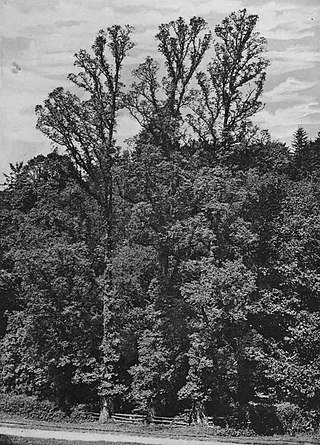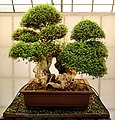
Ulmus rubra, the slippery elm, is a species of elm native to eastern North America. Other common names include red elm, gray elm, soft elm, moose elm, and Indian elm.

Ulmus crassifoliaNutt., the Texas cedar elm or simply cedar elm, is a deciduous tree native to south-central North America, mainly in southern and eastern Texas, southern Oklahoma, Arkansas, and Louisiana, with small populations in western Mississippi, southwest Tennessee, and north-central Florida; it also occurs in northeastern Mexico. It is the most common elm tree in Texas. The tree typically grows well in flat valley bottom areas referred to as cedar elm flats. Its Latin name refers to its comparatively thick (crassifoliate) leaves; the common name cedar elm is derived from the trees' association with juniper trees, locally known as cedars.

Ulmus pumila, the Siberian elm, is a tree native to Asia. It is also known as the Asiatic elm and dwarf elm, but sometimes miscalled the 'Chinese elm'. U. pumila has been widely cultivated throughout Asia, North America, Argentina, and southern Europe, becoming naturalized in many places, notably across much of the United States.

Ulmus davidiana var. japonica, the Japanese elm, is one of the larger and more graceful Asiatic elms, endemic to much of continental northeast Asia and Japan, where it grows in swamp forest on young alluvial soils, although much of this habitat has now been lost to intensive rice cultivation.

Ulmus castaneifoliaHemsley, the chestnut-leafed elm or multinerved elm, is a small deciduous tree found across much of China in broadleaved forests at elevations of 500–1,600 metres (1,600–5,200 ft).

Ulmus laciniata(Trautv.) Mayr, known variously as the Manchurian, cut-leaf, or lobed elm, is a deciduous tree native to the humid ravine forests of Japan, Korea, northern China, eastern Siberia and Sakhalin, growing alongside Cercidiphyllum japonicum, Aesculus turbinata, and Pterocarya rhoifolia, at elevations of 700–2200 m, though sometimes lower in more northern latitudes, notably in Hokkaido.

Ulmus macrocarpaHance, the large-fruited elm, is a deciduous tree or large shrub endemic to the Far East excluding Japan. It is notable for its tolerance of drought and extreme cold and is the predominant vegetation on the dunes of the Khorchin sandy lands in the Jilin province of north-eastern China, making a small tree at the base of the dunes, and a shrub at the top.

The field elm cultivar Ulmus minor 'Stricta', known as Cornish elm, was commonly found in South West England, Brittany, and south-west Ireland, until the arrival of Dutch elm disease in the late 1960s. The origin of Cornish elm in the south-west of Britain remains a matter of contention. It is commonly assumed to have been introduced from Brittany. It is also considered possible that the tree may have survived the ice ages on lands to the south of Cornwall long since lost to the sea. Henry thought it "probably native in the south of Ireland". Dr Max Coleman of Royal Botanic Garden Edinburgh, arguing in his 2002 paper on British elms that there was no clear distinction between species and subspecies, suggested that known or suspected clones of Ulmus minor, once cultivated and named, should be treated as cultivars, preferred the designation U. minor 'Stricta' to Ulmus minor var. stricta. The DNA of 'Stricta' has been investigated and the cultivar is now known to be a clone.

The hybrid elm cultivar Ulmus × hollandica 'Wredei', also known as Ulmus × hollandica 'Dampieri Aurea' and sometimes marketed as Golden Elm, originated as a sport of the cultivar 'Dampieri' at the Alt-Geltow Arboretum, near Potsdam, Germany, in 1875.

The Wych Elm cultivar Ulmus glabra 'Lutescens', commonly known as the Golden Wych Elm, arose as a sort of a wych found in the York area in the early 19th century by W. Pontey of Pontey's nursery, Kirkheaton, Huddersfield, who propagated and distributed it. The original tree he named the Gallows Elm for its proximity to a gallows near York. Loudon in The Gardener's Magazine (1839) identified it as a form of Ulmus montana, adding 'Lutescens' by analogy with Corstorphine sycamore, Acer pseudoplatanus 'Lutescens'.

The Wych Elm cultivar Ulmus glabra 'Horizontalis', commonly known as the Weeping Wych Elm or Horizontal Elm, was discovered in a Perth nursery circa 1816. The tree was originally identified as 'Pendula' by Loddiges (London), in his catalogue of 1836, a name adopted by Loudon two years later in Arboretum et Fruticetum Britannicum, 3: 1398, 1838, but later sunk as a synonym for 'Horizontalis'.

The Wych Elm cultivar Ulmus glabra 'Cornuta', in cultivation before 1845 – Fontaine (1968) gives its provenance as France, 1835 – is a little-known tree, finally identified as a cultivar of U. glabra by Boom in Nederlandse Dendrologie 1: 157, 1959.

The Field Elm cultivar Ulmus minor 'Umbraculifera' [:shade-giving] was originally cultivated in Iran, where it was widely planted as an ornamental and occasionally grew to a great size, being known there as 'Nalband' Persian: نعلبند [:the tree of the farriers]. Litvinov considered it a cultivar of a wild elm with a dense crown that he called U. densa, from the mountains of Turkestan, Ferghana, and Aksu. Non-rounded forms of 'Umbraculifera' are also found in Isfahan Province, Iran. Zielińksi in Flora Iranica considered it an U. minor cultivar.

The Siberian Elm cultivar Ulmus pumila 'Pendula' is from northern China, where it is known as Lung chao yü shu. It was classified by Frank Meyer in Fengtai in 1908, and introduced to the United States by him from the Peking Botanical Garden as Weeping Chinese Elm. The USDA plant inventory record (1916) noted that it was a "rare variety even in China". It was confirmed as an U. pumila cultivar by Krüssmann (1962).

Ulmus 'Louis van Houtte' is believed to have been first cultivated in Ghent, Belgium circa 1863. It was first mentioned by Franz Deegen in 1886. It was once thought a cultivar of English Elm Ulmus minor 'Atinia', though this derivation has long been questioned; W. J. Bean called it "an elm of uncertain status". Its dissimilarity from the type and its Belgian provenance make the 'Atinia' attribution unlikely. Fontaine (1968) considered it probably a form of U. × hollandica.

The Field Elm cultivar Ulmus minor 'Umbraculifera Gracilis' was obtained as a sport of 'Umbraculifera' by the Späth nursery of Berlin c.1897. It was marketed by the Späth nursery in the early 20th century, and by the Hesse Nursery of Weener, Germany, in the 1930s.

The 'dwarf' elm cultivar Ulmus 'Jacqueline Hillier' ('JH') is an elm of uncertain origin. It was cloned from a specimen found in a private garden in Selly Park, Birmingham, England, in 1966. The garden's owner told Hillier that it might have been introduced from outside the country by a relative. Hillier at first conjectured U. minor, as did Heybroek (2009). Identical-looking elm cultivars in Russia are labelled forms of Siberian Elm, Ulmus pumila, which is known to produce 'JH'-type long shoots. Melville considered 'JH' a hybrid cultivar from the 'Elegantissima' group of Ulmus × hollandica. Uncertainty about its parentage has led most nurserymen to list the tree simply as Ulmus 'Jacqueline Hillier'. 'JH' is not known to produce flowers and samarae, or root suckers.

The Chinese Elm cultivar Ulmus parvifolia 'Hokkaido' is an older cultivar of Japanese origin.
Ulmus bergmanniana var. lasiophyllaC. K. Schneid. is endemic to China, on mountain slopes at elevations of 2100–2900 m in Gansu, Shaanxi, north-west Sichuan, south-east Xizang, and north-west Yunnan.

The Siberian elm cultivar Ulmus pumila 'Pinnato-ramosa' was raised by Georg Dieck, as Ulmus pinnato-ramosa, at the National Arboretum, Zöschen, Germany, from seed collected for him circa 1890 in the Ili valley, Turkestan by the lawyer and amateur naturalist Vladislav E. Niedzwiecki while in exile there. Litvinov (1908) treated it as a variety of Siberian elm, U. pumilavar.arborea but this taxon was ultimately rejected by Green, who sank the tree as a cultivar: "in modern terms, it does not warrant recognition at this rank but is a variant of U. pumila maintained and known only in cultivation, and therefore best treated as a cultivar". Herbarium specimens confirm that trees in cultivation in the 20th century as U. pumilaL. var. arboreaLitv. were no different from 'Pinnato-ramosa'.
































